Health and Social Care: Safeguarding Report on Vulnerable Individuals
VerifiedAdded on 2020/10/22
|11
|3951
|97
Report
AI Summary
This report examines safeguarding practices within health and social care, focusing on the specific context of Moorwood Cottage Care Home. It begins by defining abuse and identifying vulnerable groups, particularly the elderly, detailing the types of abuse they may experience, including neglect, psychological abuse, and institutional abuse. The report then analyzes risk factors contributing to abuse, such as ineffective fluid monitoring, inconsistent hygiene practices, and insufficient provision of drinks. It includes a risk assessment table and proposes action plans to mitigate these risks. The influence of social and cultural factors, such as lack of education and discrimination, on the incidence of abuse is also discussed. The report then analyzes the strengths and weaknesses of current legislation and policies, including the Health and Social Care Act 2012, the Equality Act 2010, and the Social Value Act 2012, and explains how key professionals are involved in protecting vulnerable individuals. The report emphasizes the importance of professional involvement, including nurses and healthcare staff, in providing care and protection to residents. The report provides a comprehensive overview of the critical aspects of safeguarding within the health and social care sector.
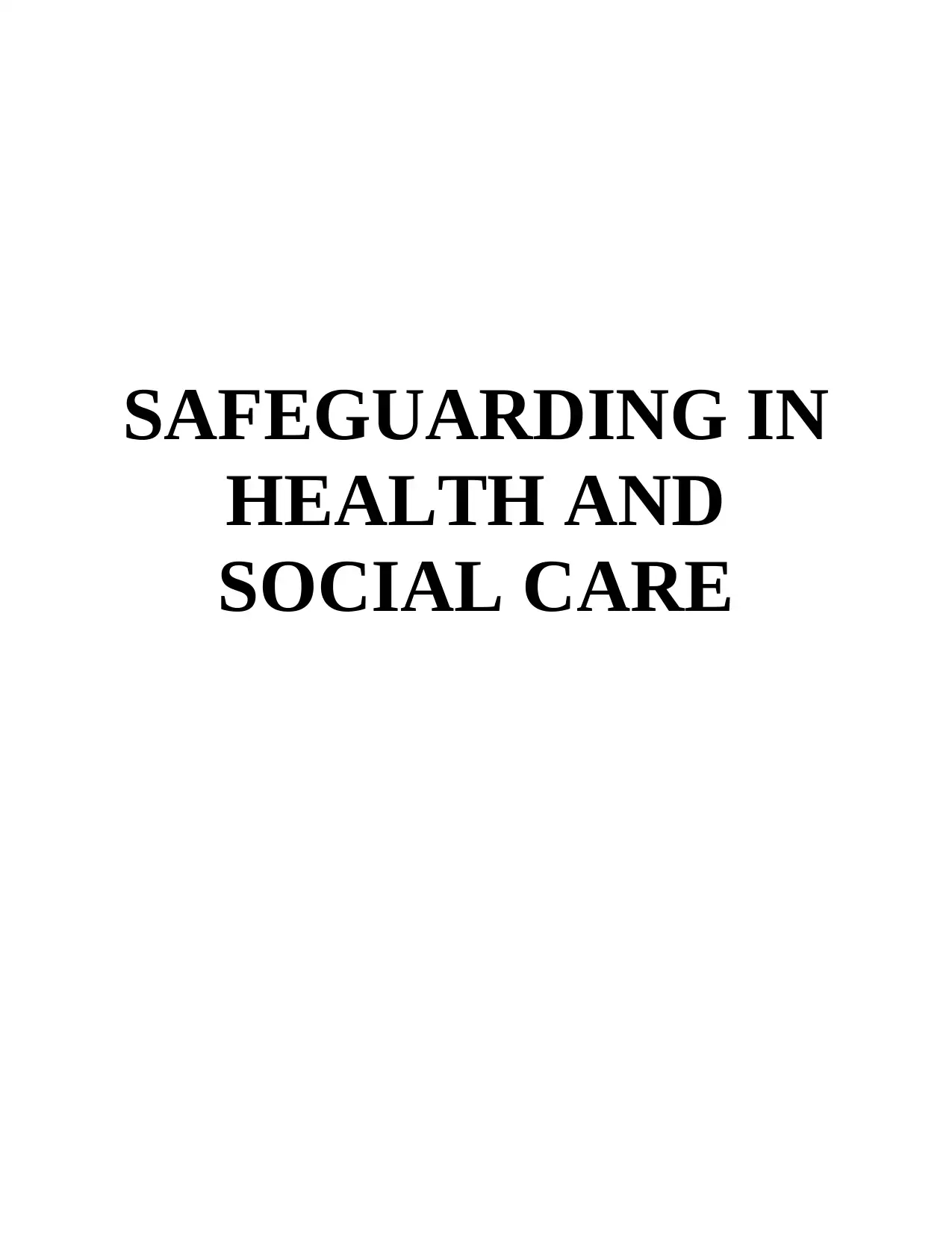
SAFEGUARDING IN
HEALTH AND
SOCIAL CARE
HEALTH AND
SOCIAL CARE
Paraphrase This Document
Need a fresh take? Get an instant paraphrase of this document with our AI Paraphraser
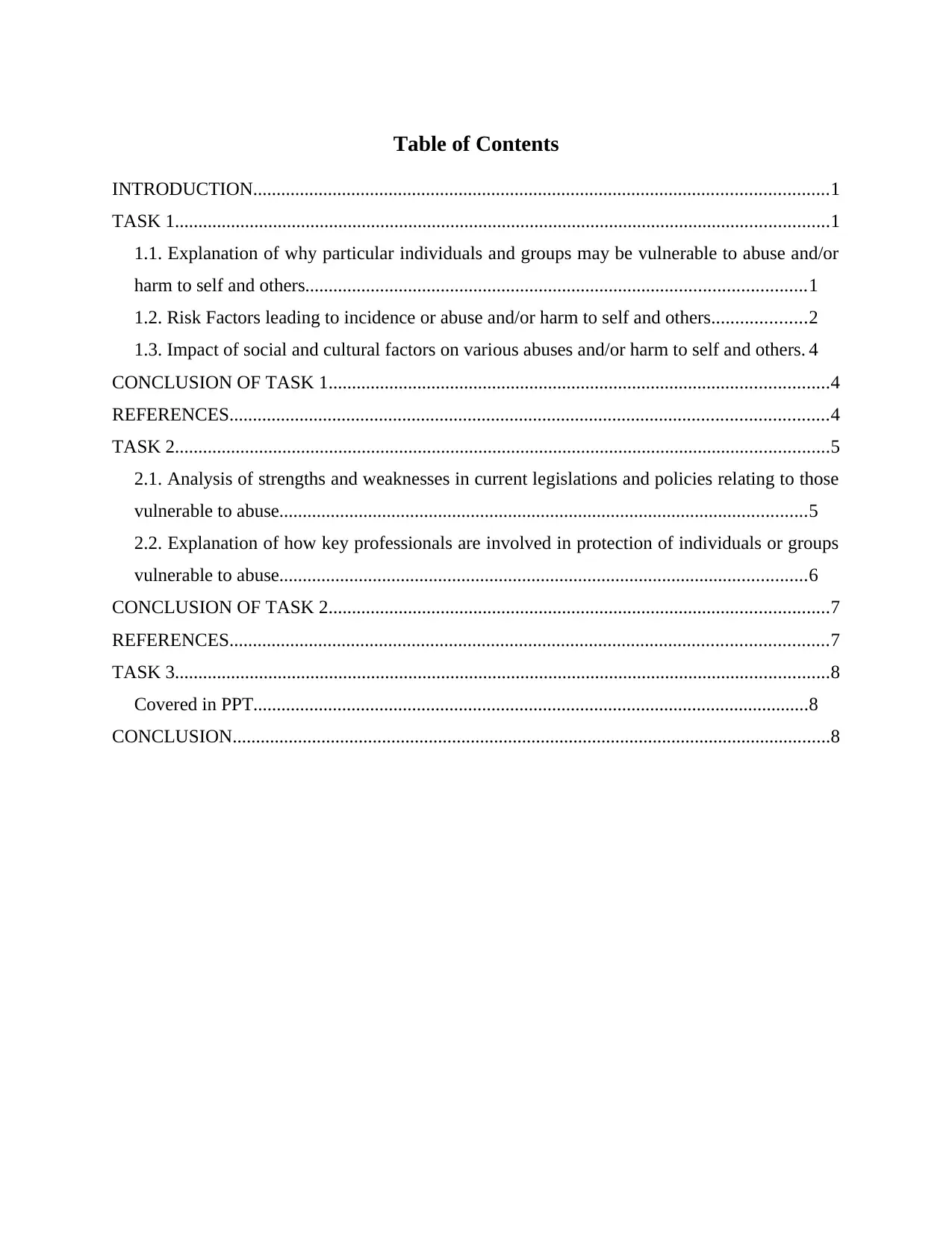
Table of Contents
INTRODUCTION...........................................................................................................................1
TASK 1............................................................................................................................................1
1.1. Explanation of why particular individuals and groups may be vulnerable to abuse and/or
harm to self and others...........................................................................................................1
1.2. Risk Factors leading to incidence or abuse and/or harm to self and others....................2
1.3. Impact of social and cultural factors on various abuses and/or harm to self and others. 4
CONCLUSION OF TASK 1...........................................................................................................4
REFERENCES................................................................................................................................4
TASK 2............................................................................................................................................5
2.1. Analysis of strengths and weaknesses in current legislations and policies relating to those
vulnerable to abuse.................................................................................................................5
2.2. Explanation of how key professionals are involved in protection of individuals or groups
vulnerable to abuse.................................................................................................................6
CONCLUSION OF TASK 2...........................................................................................................7
REFERENCES................................................................................................................................7
TASK 3............................................................................................................................................8
Covered in PPT.......................................................................................................................8
CONCLUSION................................................................................................................................8
INTRODUCTION...........................................................................................................................1
TASK 1............................................................................................................................................1
1.1. Explanation of why particular individuals and groups may be vulnerable to abuse and/or
harm to self and others...........................................................................................................1
1.2. Risk Factors leading to incidence or abuse and/or harm to self and others....................2
1.3. Impact of social and cultural factors on various abuses and/or harm to self and others. 4
CONCLUSION OF TASK 1...........................................................................................................4
REFERENCES................................................................................................................................4
TASK 2............................................................................................................................................5
2.1. Analysis of strengths and weaknesses in current legislations and policies relating to those
vulnerable to abuse.................................................................................................................5
2.2. Explanation of how key professionals are involved in protection of individuals or groups
vulnerable to abuse.................................................................................................................6
CONCLUSION OF TASK 2...........................................................................................................7
REFERENCES................................................................................................................................7
TASK 3............................................................................................................................................8
Covered in PPT.......................................................................................................................8
CONCLUSION................................................................................................................................8
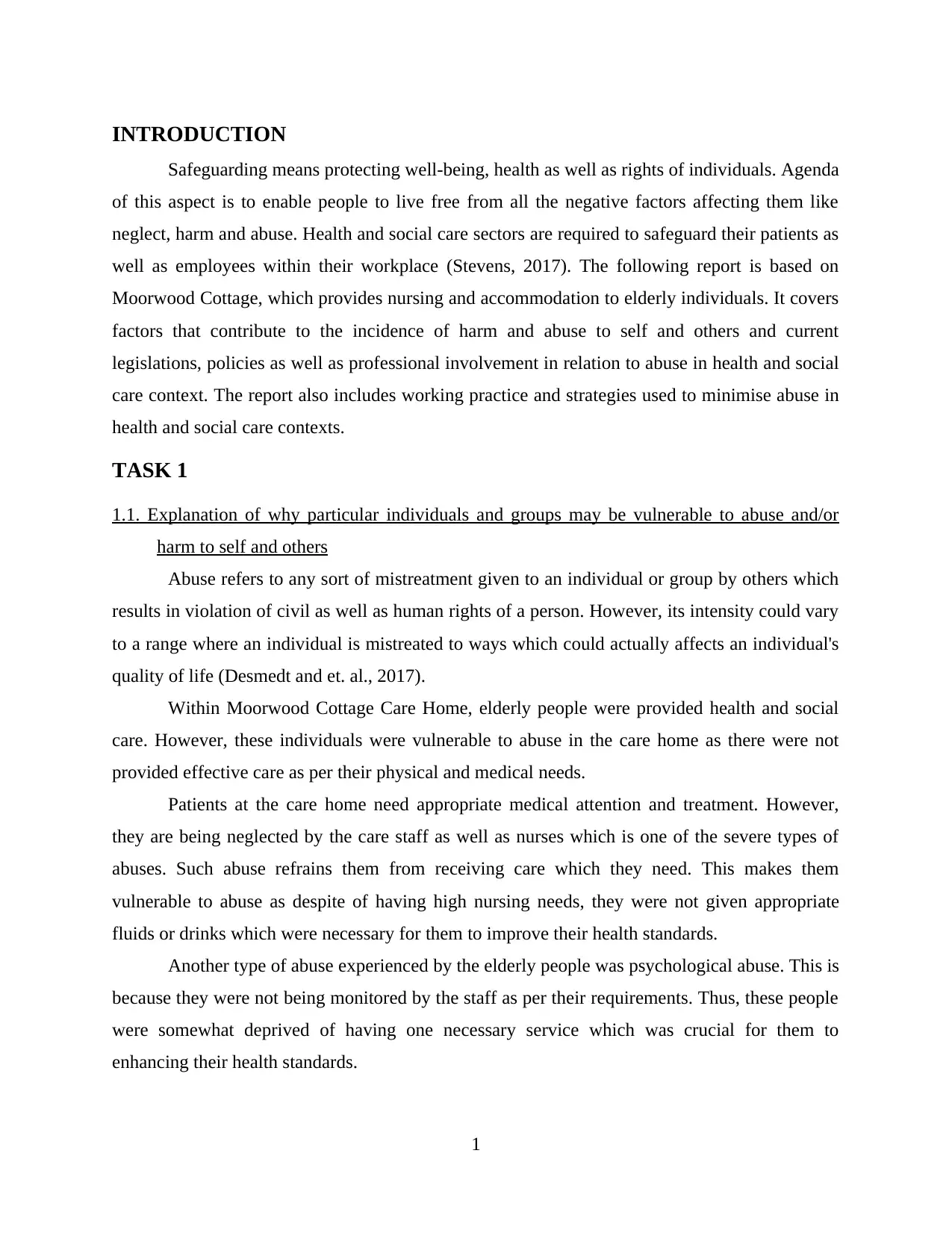
INTRODUCTION
Safeguarding means protecting well-being, health as well as rights of individuals. Agenda
of this aspect is to enable people to live free from all the negative factors affecting them like
neglect, harm and abuse. Health and social care sectors are required to safeguard their patients as
well as employees within their workplace (Stevens, 2017). The following report is based on
Moorwood Cottage, which provides nursing and accommodation to elderly individuals. It covers
factors that contribute to the incidence of harm and abuse to self and others and current
legislations, policies as well as professional involvement in relation to abuse in health and social
care context. The report also includes working practice and strategies used to minimise abuse in
health and social care contexts.
TASK 1
1.1. Explanation of why particular individuals and groups may be vulnerable to abuse and/or
harm to self and others
Abuse refers to any sort of mistreatment given to an individual or group by others which
results in violation of civil as well as human rights of a person. However, its intensity could vary
to a range where an individual is mistreated to ways which could actually affects an individual's
quality of life (Desmedt and et. al., 2017).
Within Moorwood Cottage Care Home, elderly people were provided health and social
care. However, these individuals were vulnerable to abuse in the care home as there were not
provided effective care as per their physical and medical needs.
Patients at the care home need appropriate medical attention and treatment. However,
they are being neglected by the care staff as well as nurses which is one of the severe types of
abuses. Such abuse refrains them from receiving care which they need. This makes them
vulnerable to abuse as despite of having high nursing needs, they were not given appropriate
fluids or drinks which were necessary for them to improve their health standards.
Another type of abuse experienced by the elderly people was psychological abuse. This is
because they were not being monitored by the staff as per their requirements. Thus, these people
were somewhat deprived of having one necessary service which was crucial for them to
enhancing their health standards.
1
Safeguarding means protecting well-being, health as well as rights of individuals. Agenda
of this aspect is to enable people to live free from all the negative factors affecting them like
neglect, harm and abuse. Health and social care sectors are required to safeguard their patients as
well as employees within their workplace (Stevens, 2017). The following report is based on
Moorwood Cottage, which provides nursing and accommodation to elderly individuals. It covers
factors that contribute to the incidence of harm and abuse to self and others and current
legislations, policies as well as professional involvement in relation to abuse in health and social
care context. The report also includes working practice and strategies used to minimise abuse in
health and social care contexts.
TASK 1
1.1. Explanation of why particular individuals and groups may be vulnerable to abuse and/or
harm to self and others
Abuse refers to any sort of mistreatment given to an individual or group by others which
results in violation of civil as well as human rights of a person. However, its intensity could vary
to a range where an individual is mistreated to ways which could actually affects an individual's
quality of life (Desmedt and et. al., 2017).
Within Moorwood Cottage Care Home, elderly people were provided health and social
care. However, these individuals were vulnerable to abuse in the care home as there were not
provided effective care as per their physical and medical needs.
Patients at the care home need appropriate medical attention and treatment. However,
they are being neglected by the care staff as well as nurses which is one of the severe types of
abuses. Such abuse refrains them from receiving care which they need. This makes them
vulnerable to abuse as despite of having high nursing needs, they were not given appropriate
fluids or drinks which were necessary for them to improve their health standards.
Another type of abuse experienced by the elderly people was psychological abuse. This is
because they were not being monitored by the staff as per their requirements. Thus, these people
were somewhat deprived of having one necessary service which was crucial for them to
enhancing their health standards.
1
⊘ This is a preview!⊘
Do you want full access?
Subscribe today to unlock all pages.

Trusted by 1+ million students worldwide
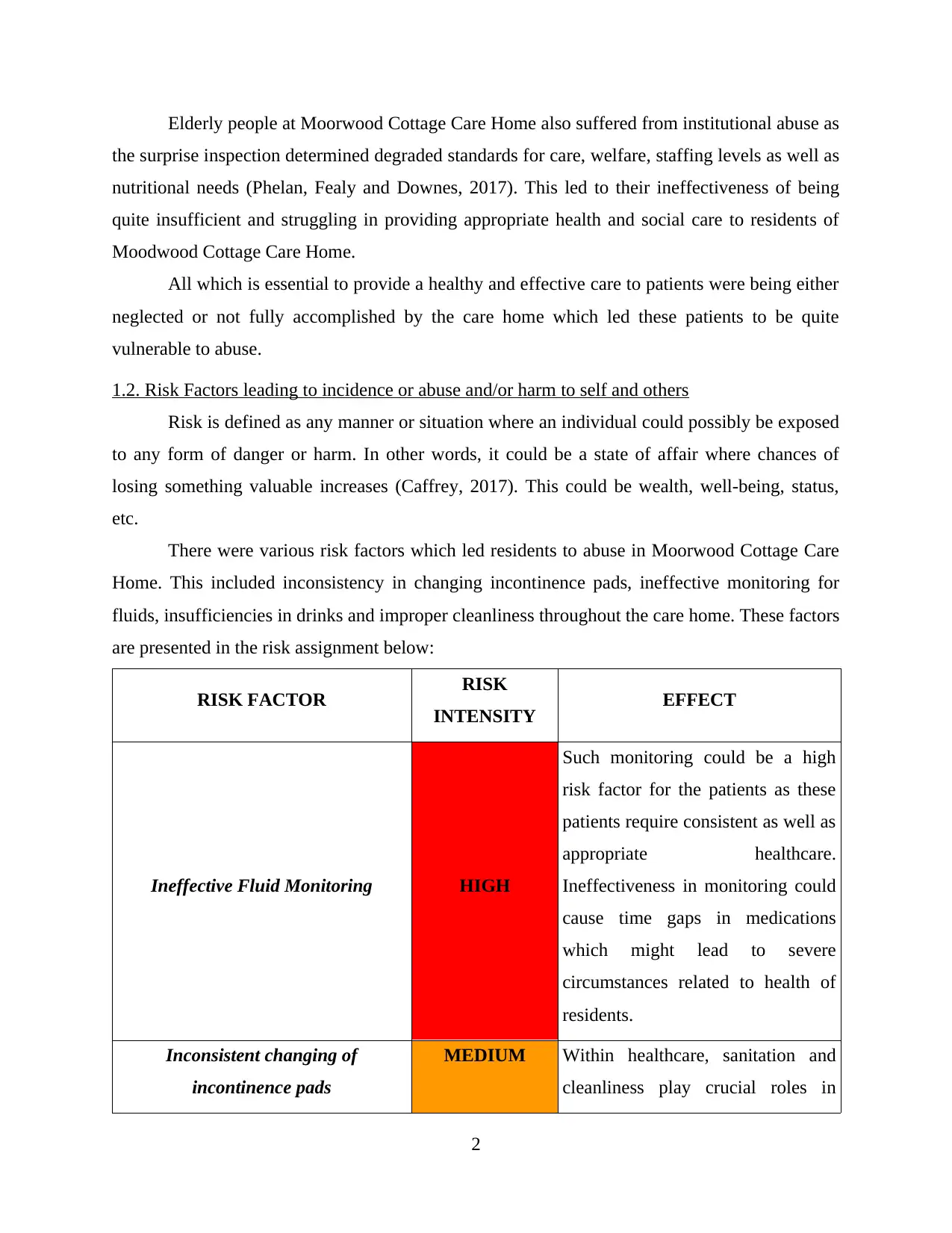
Elderly people at Moorwood Cottage Care Home also suffered from institutional abuse as
the surprise inspection determined degraded standards for care, welfare, staffing levels as well as
nutritional needs (Phelan, Fealy and Downes, 2017). This led to their ineffectiveness of being
quite insufficient and struggling in providing appropriate health and social care to residents of
Moodwood Cottage Care Home.
All which is essential to provide a healthy and effective care to patients were being either
neglected or not fully accomplished by the care home which led these patients to be quite
vulnerable to abuse.
1.2. Risk Factors leading to incidence or abuse and/or harm to self and others
Risk is defined as any manner or situation where an individual could possibly be exposed
to any form of danger or harm. In other words, it could be a state of affair where chances of
losing something valuable increases (Caffrey, 2017). This could be wealth, well-being, status,
etc.
There were various risk factors which led residents to abuse in Moorwood Cottage Care
Home. This included inconsistency in changing incontinence pads, ineffective monitoring for
fluids, insufficiencies in drinks and improper cleanliness throughout the care home. These factors
are presented in the risk assignment below:
RISK FACTOR RISK
INTENSITY EFFECT
Ineffective Fluid Monitoring HIGH
Such monitoring could be a high
risk factor for the patients as these
patients require consistent as well as
appropriate healthcare.
Ineffectiveness in monitoring could
cause time gaps in medications
which might lead to severe
circumstances related to health of
residents.
Inconsistent changing of
incontinence pads
MEDIUM Within healthcare, sanitation and
cleanliness play crucial roles in
2
the surprise inspection determined degraded standards for care, welfare, staffing levels as well as
nutritional needs (Phelan, Fealy and Downes, 2017). This led to their ineffectiveness of being
quite insufficient and struggling in providing appropriate health and social care to residents of
Moodwood Cottage Care Home.
All which is essential to provide a healthy and effective care to patients were being either
neglected or not fully accomplished by the care home which led these patients to be quite
vulnerable to abuse.
1.2. Risk Factors leading to incidence or abuse and/or harm to self and others
Risk is defined as any manner or situation where an individual could possibly be exposed
to any form of danger or harm. In other words, it could be a state of affair where chances of
losing something valuable increases (Caffrey, 2017). This could be wealth, well-being, status,
etc.
There were various risk factors which led residents to abuse in Moorwood Cottage Care
Home. This included inconsistency in changing incontinence pads, ineffective monitoring for
fluids, insufficiencies in drinks and improper cleanliness throughout the care home. These factors
are presented in the risk assignment below:
RISK FACTOR RISK
INTENSITY EFFECT
Ineffective Fluid Monitoring HIGH
Such monitoring could be a high
risk factor for the patients as these
patients require consistent as well as
appropriate healthcare.
Ineffectiveness in monitoring could
cause time gaps in medications
which might lead to severe
circumstances related to health of
residents.
Inconsistent changing of
incontinence pads
MEDIUM Within healthcare, sanitation and
cleanliness play crucial roles in
2
Paraphrase This Document
Need a fresh take? Get an instant paraphrase of this document with our AI Paraphraser

providing quality healthcare to
patients. However, Within
Moorwood Cottage Care Home, due
to inconsistencies in changing of
incontinence pads could result in
residents suffering from various
infections which might risk their
health conditions.
Insufficient Drinks MEDIUM
Residents at the care home are
elderly people who require
appropriate meals and drinks timely.
Effective timetable in meals help
them in fulfilling their daily needs
appropriately. Insufficiency in
drinks would keep their nutrition
demands unmet that would cause
them to be sick and unable to cope
up with their health.
However, with such degrading standards, it is essential that action plan is made which
would be giving various specific methods and techniques that would help Moorwood Cottage
Care Home in effectively accomplish healthcare standards and provide quality service to its
residents.
The first and foremost action plan would be to provide training to staff regarding
development of consistencies in their job roles. This would be effective in terms of monitoring of
dosages and appropriate consistency in drinks (Bryar, 2017).
Another action plan could be implementing personnels overseeing the hygiene and
cleanliness standards for residents. Sanitation methods applied by these personnels would
safeguard the people within Moorwood Cottage Care Home from any sort of infections that
might worsen their health.
3
patients. However, Within
Moorwood Cottage Care Home, due
to inconsistencies in changing of
incontinence pads could result in
residents suffering from various
infections which might risk their
health conditions.
Insufficient Drinks MEDIUM
Residents at the care home are
elderly people who require
appropriate meals and drinks timely.
Effective timetable in meals help
them in fulfilling their daily needs
appropriately. Insufficiency in
drinks would keep their nutrition
demands unmet that would cause
them to be sick and unable to cope
up with their health.
However, with such degrading standards, it is essential that action plan is made which
would be giving various specific methods and techniques that would help Moorwood Cottage
Care Home in effectively accomplish healthcare standards and provide quality service to its
residents.
The first and foremost action plan would be to provide training to staff regarding
development of consistencies in their job roles. This would be effective in terms of monitoring of
dosages and appropriate consistency in drinks (Bryar, 2017).
Another action plan could be implementing personnels overseeing the hygiene and
cleanliness standards for residents. Sanitation methods applied by these personnels would
safeguard the people within Moorwood Cottage Care Home from any sort of infections that
might worsen their health.
3
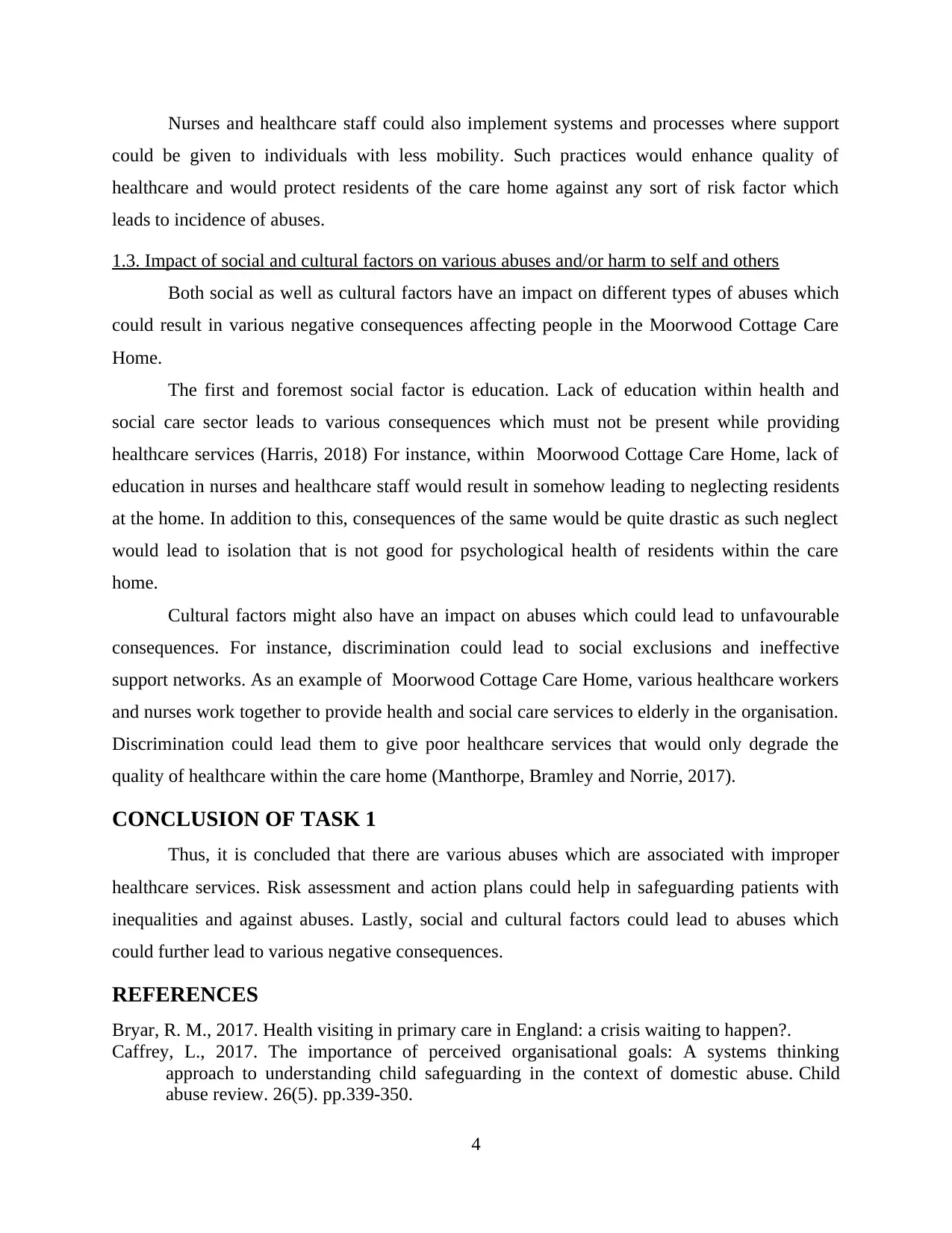
Nurses and healthcare staff could also implement systems and processes where support
could be given to individuals with less mobility. Such practices would enhance quality of
healthcare and would protect residents of the care home against any sort of risk factor which
leads to incidence of abuses.
1.3. Impact of social and cultural factors on various abuses and/or harm to self and others
Both social as well as cultural factors have an impact on different types of abuses which
could result in various negative consequences affecting people in the Moorwood Cottage Care
Home.
The first and foremost social factor is education. Lack of education within health and
social care sector leads to various consequences which must not be present while providing
healthcare services (Harris, 2018) For instance, within Moorwood Cottage Care Home, lack of
education in nurses and healthcare staff would result in somehow leading to neglecting residents
at the home. In addition to this, consequences of the same would be quite drastic as such neglect
would lead to isolation that is not good for psychological health of residents within the care
home.
Cultural factors might also have an impact on abuses which could lead to unfavourable
consequences. For instance, discrimination could lead to social exclusions and ineffective
support networks. As an example of Moorwood Cottage Care Home, various healthcare workers
and nurses work together to provide health and social care services to elderly in the organisation.
Discrimination could lead them to give poor healthcare services that would only degrade the
quality of healthcare within the care home (Manthorpe, Bramley and Norrie, 2017).
CONCLUSION OF TASK 1
Thus, it is concluded that there are various abuses which are associated with improper
healthcare services. Risk assessment and action plans could help in safeguarding patients with
inequalities and against abuses. Lastly, social and cultural factors could lead to abuses which
could further lead to various negative consequences.
REFERENCES
Bryar, R. M., 2017. Health visiting in primary care in England: a crisis waiting to happen?.
Caffrey, L., 2017. The importance of perceived organisational goals: A systems thinking
approach to understanding child safeguarding in the context of domestic abuse. Child
abuse review. 26(5). pp.339-350.
4
could be given to individuals with less mobility. Such practices would enhance quality of
healthcare and would protect residents of the care home against any sort of risk factor which
leads to incidence of abuses.
1.3. Impact of social and cultural factors on various abuses and/or harm to self and others
Both social as well as cultural factors have an impact on different types of abuses which
could result in various negative consequences affecting people in the Moorwood Cottage Care
Home.
The first and foremost social factor is education. Lack of education within health and
social care sector leads to various consequences which must not be present while providing
healthcare services (Harris, 2018) For instance, within Moorwood Cottage Care Home, lack of
education in nurses and healthcare staff would result in somehow leading to neglecting residents
at the home. In addition to this, consequences of the same would be quite drastic as such neglect
would lead to isolation that is not good for psychological health of residents within the care
home.
Cultural factors might also have an impact on abuses which could lead to unfavourable
consequences. For instance, discrimination could lead to social exclusions and ineffective
support networks. As an example of Moorwood Cottage Care Home, various healthcare workers
and nurses work together to provide health and social care services to elderly in the organisation.
Discrimination could lead them to give poor healthcare services that would only degrade the
quality of healthcare within the care home (Manthorpe, Bramley and Norrie, 2017).
CONCLUSION OF TASK 1
Thus, it is concluded that there are various abuses which are associated with improper
healthcare services. Risk assessment and action plans could help in safeguarding patients with
inequalities and against abuses. Lastly, social and cultural factors could lead to abuses which
could further lead to various negative consequences.
REFERENCES
Bryar, R. M., 2017. Health visiting in primary care in England: a crisis waiting to happen?.
Caffrey, L., 2017. The importance of perceived organisational goals: A systems thinking
approach to understanding child safeguarding in the context of domestic abuse. Child
abuse review. 26(5). pp.339-350.
4
⊘ This is a preview!⊘
Do you want full access?
Subscribe today to unlock all pages.

Trusted by 1+ million students worldwide
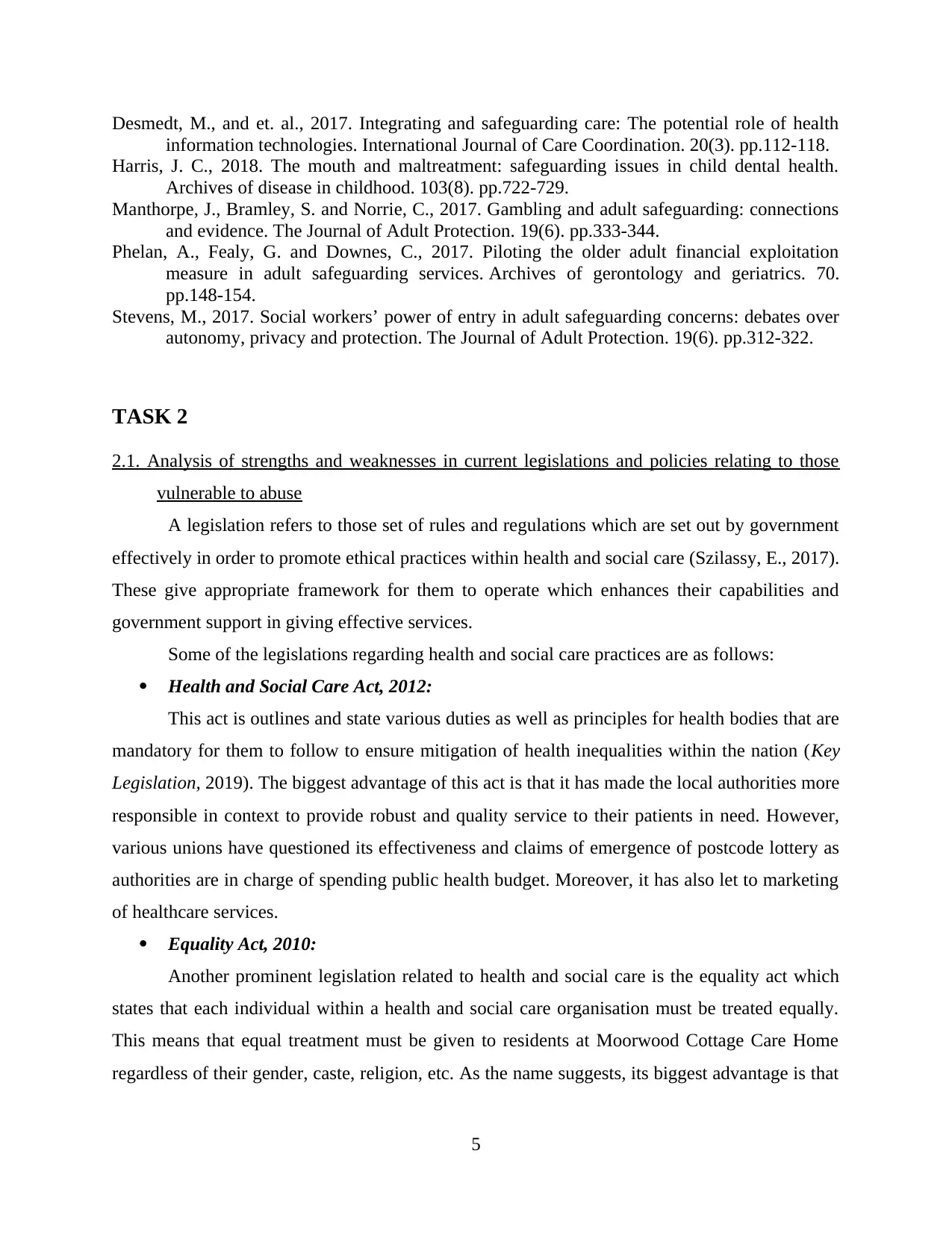
Desmedt, M., and et. al., 2017. Integrating and safeguarding care: The potential role of health
information technologies. International Journal of Care Coordination. 20(3). pp.112-118.
Harris, J. C., 2018. The mouth and maltreatment: safeguarding issues in child dental health.
Archives of disease in childhood. 103(8). pp.722-729.
Manthorpe, J., Bramley, S. and Norrie, C., 2017. Gambling and adult safeguarding: connections
and evidence. The Journal of Adult Protection. 19(6). pp.333-344.
Phelan, A., Fealy, G. and Downes, C., 2017. Piloting the older adult financial exploitation
measure in adult safeguarding services. Archives of gerontology and geriatrics. 70.
pp.148-154.
Stevens, M., 2017. Social workers’ power of entry in adult safeguarding concerns: debates over
autonomy, privacy and protection. The Journal of Adult Protection. 19(6). pp.312-322.
TASK 2
2.1. Analysis of strengths and weaknesses in current legislations and policies relating to those
vulnerable to abuse
A legislation refers to those set of rules and regulations which are set out by government
effectively in order to promote ethical practices within health and social care (Szilassy, E., 2017).
These give appropriate framework for them to operate which enhances their capabilities and
government support in giving effective services.
Some of the legislations regarding health and social care practices are as follows:
Health and Social Care Act, 2012:
This act is outlines and state various duties as well as principles for health bodies that are
mandatory for them to follow to ensure mitigation of health inequalities within the nation (Key
Legislation, 2019). The biggest advantage of this act is that it has made the local authorities more
responsible in context to provide robust and quality service to their patients in need. However,
various unions have questioned its effectiveness and claims of emergence of postcode lottery as
authorities are in charge of spending public health budget. Moreover, it has also let to marketing
of healthcare services.
Equality Act, 2010:
Another prominent legislation related to health and social care is the equality act which
states that each individual within a health and social care organisation must be treated equally.
This means that equal treatment must be given to residents at Moorwood Cottage Care Home
regardless of their gender, caste, religion, etc. As the name suggests, its biggest advantage is that
5
information technologies. International Journal of Care Coordination. 20(3). pp.112-118.
Harris, J. C., 2018. The mouth and maltreatment: safeguarding issues in child dental health.
Archives of disease in childhood. 103(8). pp.722-729.
Manthorpe, J., Bramley, S. and Norrie, C., 2017. Gambling and adult safeguarding: connections
and evidence. The Journal of Adult Protection. 19(6). pp.333-344.
Phelan, A., Fealy, G. and Downes, C., 2017. Piloting the older adult financial exploitation
measure in adult safeguarding services. Archives of gerontology and geriatrics. 70.
pp.148-154.
Stevens, M., 2017. Social workers’ power of entry in adult safeguarding concerns: debates over
autonomy, privacy and protection. The Journal of Adult Protection. 19(6). pp.312-322.
TASK 2
2.1. Analysis of strengths and weaknesses in current legislations and policies relating to those
vulnerable to abuse
A legislation refers to those set of rules and regulations which are set out by government
effectively in order to promote ethical practices within health and social care (Szilassy, E., 2017).
These give appropriate framework for them to operate which enhances their capabilities and
government support in giving effective services.
Some of the legislations regarding health and social care practices are as follows:
Health and Social Care Act, 2012:
This act is outlines and state various duties as well as principles for health bodies that are
mandatory for them to follow to ensure mitigation of health inequalities within the nation (Key
Legislation, 2019). The biggest advantage of this act is that it has made the local authorities more
responsible in context to provide robust and quality service to their patients in need. However,
various unions have questioned its effectiveness and claims of emergence of postcode lottery as
authorities are in charge of spending public health budget. Moreover, it has also let to marketing
of healthcare services.
Equality Act, 2010:
Another prominent legislation related to health and social care is the equality act which
states that each individual within a health and social care organisation must be treated equally.
This means that equal treatment must be given to residents at Moorwood Cottage Care Home
regardless of their gender, caste, religion, etc. As the name suggests, its biggest advantage is that
5
Paraphrase This Document
Need a fresh take? Get an instant paraphrase of this document with our AI Paraphraser

it promotes equality which protects individuals from abuses within the care home. However, in
some cases, age discrimination is allowed unless a legitimate aim is being imposed.
Social Value Act, 2012:
This act requires local authorities and public sector commissioners to consider social,
economic as well as environmental well-being in procurement of services. This act appropriately
helps patients in receiving effective treatment and enables organisations like Moorwood Cottage
Care Home in reducing health inequalities (Taylor, J. L., 2017). However, there are
disadvantages associated with this act. For instance, there are uncertainties which is associated
with procurement of contracts.
However, drawbacks are associated with these regulations, these aspects are crucial for
health and social care and could be useful to Moorwood Cottage Care Home to provide effective
services to its residents (Soini, E., 2018).
2.2. Explanation of how key professionals are involved in protection of individuals or groups
vulnerable to abuse
It is crucial for professionals at care home to provide utmost facilities and care to
residents. It is of vital importance as elderly people present within Moorwood Cottage Care
Home are entitled to protection from abuses.
As for this care home, there are two crucial professionals that are involved within
protection of residents from abuse (Stevens, M., 2018).
Regional as well as registered manager in Moorwood Cottage Care Home have been
involved in protecting individuals from abuses by raising the standards of care given within the
healthcare organisation. These professionals undertook responsibility to improve the standards of
care home by effectively modifying and bringing up positive changes within the care home.
These changes were associated with culture of the care home, overall environment and health
standards for residents (Cooper, A. and Bruin, C., 2017).
Where staff of Moorwood Cottage Care Home is concerned, they were made to monitor
periodically which could protect individuals from harm and any sort of risk. The agenda behind
this effectively was to effectively record useful information necessary for providing quality care
to elderly people within the care home (Kupeli, N., Leavey, G., and Harrington, J., 2018).
Staff rotas were also reorganised to achieve appropriate care standards within the care
home. Moreover, a new initiative known as fluid champion was initiated which was concerned
6
some cases, age discrimination is allowed unless a legitimate aim is being imposed.
Social Value Act, 2012:
This act requires local authorities and public sector commissioners to consider social,
economic as well as environmental well-being in procurement of services. This act appropriately
helps patients in receiving effective treatment and enables organisations like Moorwood Cottage
Care Home in reducing health inequalities (Taylor, J. L., 2017). However, there are
disadvantages associated with this act. For instance, there are uncertainties which is associated
with procurement of contracts.
However, drawbacks are associated with these regulations, these aspects are crucial for
health and social care and could be useful to Moorwood Cottage Care Home to provide effective
services to its residents (Soini, E., 2018).
2.2. Explanation of how key professionals are involved in protection of individuals or groups
vulnerable to abuse
It is crucial for professionals at care home to provide utmost facilities and care to
residents. It is of vital importance as elderly people present within Moorwood Cottage Care
Home are entitled to protection from abuses.
As for this care home, there are two crucial professionals that are involved within
protection of residents from abuse (Stevens, M., 2018).
Regional as well as registered manager in Moorwood Cottage Care Home have been
involved in protecting individuals from abuses by raising the standards of care given within the
healthcare organisation. These professionals undertook responsibility to improve the standards of
care home by effectively modifying and bringing up positive changes within the care home.
These changes were associated with culture of the care home, overall environment and health
standards for residents (Cooper, A. and Bruin, C., 2017).
Where staff of Moorwood Cottage Care Home is concerned, they were made to monitor
periodically which could protect individuals from harm and any sort of risk. The agenda behind
this effectively was to effectively record useful information necessary for providing quality care
to elderly people within the care home (Kupeli, N., Leavey, G., and Harrington, J., 2018).
Staff rotas were also reorganised to achieve appropriate care standards within the care
home. Moreover, a new initiative known as fluid champion was initiated which was concerned
6

with monitoring the fluid intake and giving support to those who are unable to consume fluid on
their own.
Such was the involvement of these two professionals within Moorwood Cottage Care
Home which resulted in enhancing care standards and protection from abuses and risks (Billioux,
A., 2017).
CONCLUSION OF TASK 2
It is thus concluded from information presented above that legislations and policies play
crucial roles in providing effective healthcare to patients in a care home and it is important that
their advantages and drawbacks be analysed which would help in regulating the same
appropriately. In addition to this, it is crucial that care home professionals be involved in policies
and staff routines in health and social care organisations which would help in improving
healthcare quality and protection of residents appropriately from abuses.
REFERENCES
Billioux, A., 2017. Standardized screening for health-related social needs in clinical settings: The
accountable health communities screening tool. NAM Perspectives.
Cooper, A. and Bruin, C., 2017. Adult safeguarding and the Care Act (2014)–the impacts on
partnerships and practice. The Journal of Adult Protection. 19(4). pp.209-219.
Kupeli, N., Leavey, G., and Harrington, J., 2018. What are the barriers to care integration for
those at the advanced stages of dementia living in care homes in the UK? Health care
professional perspective. Dementia. 17(2). pp.164-179.
Soini, E., 2018. Efficient secondary use of representative social and health care data in Finland:
Isaacus data lake, analytics and knowledge management pre-production project. Value in
Health. 20(9). p.A777.
Stevens, M., 2018. Implementing safeguarding and personalisation in social work: findings from
practice. Journal of Social Work. 18(1). pp.3-22.
Szilassy, E., 2017. Making the links between domestic violence and child safeguarding: an
evidence‐based pilot training for general practice. Health & social care in the community.
25(6). pp.1722-1732.
Taylor, J. L., 2017. The impact of transforming care on the care and safety of patients with
intellectual disabilities and forensic needs. BJPsych bulletin. 41(4). pp.205-208.
Online
Key Legislation. 2019. [Online] Available Through:
<https://www.england.nhs.uk/about/equality/equality-hub/resources/legislation/>
TASK 3
Covered in Poster
7
their own.
Such was the involvement of these two professionals within Moorwood Cottage Care
Home which resulted in enhancing care standards and protection from abuses and risks (Billioux,
A., 2017).
CONCLUSION OF TASK 2
It is thus concluded from information presented above that legislations and policies play
crucial roles in providing effective healthcare to patients in a care home and it is important that
their advantages and drawbacks be analysed which would help in regulating the same
appropriately. In addition to this, it is crucial that care home professionals be involved in policies
and staff routines in health and social care organisations which would help in improving
healthcare quality and protection of residents appropriately from abuses.
REFERENCES
Billioux, A., 2017. Standardized screening for health-related social needs in clinical settings: The
accountable health communities screening tool. NAM Perspectives.
Cooper, A. and Bruin, C., 2017. Adult safeguarding and the Care Act (2014)–the impacts on
partnerships and practice. The Journal of Adult Protection. 19(4). pp.209-219.
Kupeli, N., Leavey, G., and Harrington, J., 2018. What are the barriers to care integration for
those at the advanced stages of dementia living in care homes in the UK? Health care
professional perspective. Dementia. 17(2). pp.164-179.
Soini, E., 2018. Efficient secondary use of representative social and health care data in Finland:
Isaacus data lake, analytics and knowledge management pre-production project. Value in
Health. 20(9). p.A777.
Stevens, M., 2018. Implementing safeguarding and personalisation in social work: findings from
practice. Journal of Social Work. 18(1). pp.3-22.
Szilassy, E., 2017. Making the links between domestic violence and child safeguarding: an
evidence‐based pilot training for general practice. Health & social care in the community.
25(6). pp.1722-1732.
Taylor, J. L., 2017. The impact of transforming care on the care and safety of patients with
intellectual disabilities and forensic needs. BJPsych bulletin. 41(4). pp.205-208.
Online
Key Legislation. 2019. [Online] Available Through:
<https://www.england.nhs.uk/about/equality/equality-hub/resources/legislation/>
TASK 3
Covered in Poster
7
⊘ This is a preview!⊘
Do you want full access?
Subscribe today to unlock all pages.

Trusted by 1+ million students worldwide
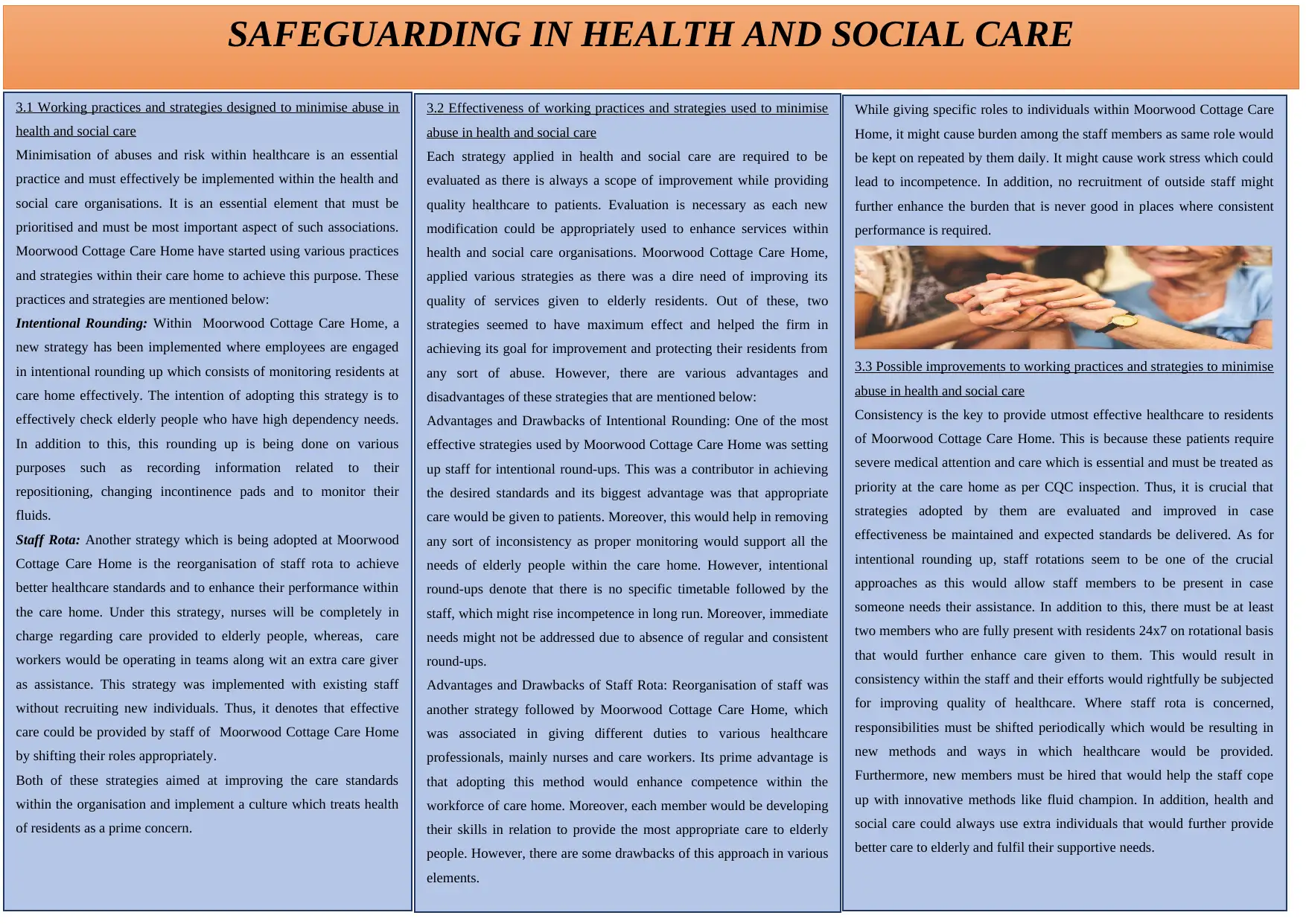
1
While giving specific roles to individuals within Moorwood Cottage Care
Home, it might cause burden among the staff members as same role would
be kept on repeated by them daily. It might cause work stress which could
lead to incompetence. In addition, no recruitment of outside staff might
further enhance the burden that is never good in places where consistent
performance is required.
3.3 Possible improvements to working practices and strategies to minimise
abuse in health and social care
Consistency is the key to provide utmost effective healthcare to residents
of Moorwood Cottage Care Home. This is because these patients require
severe medical attention and care which is essential and must be treated as
priority at the care home as per CQC inspection. Thus, it is crucial that
strategies adopted by them are evaluated and improved in case
effectiveness be maintained and expected standards be delivered. As for
intentional rounding up, staff rotations seem to be one of the crucial
approaches as this would allow staff members to be present in case
someone needs their assistance. In addition to this, there must be at least
two members who are fully present with residents 24x7 on rotational basis
that would further enhance care given to them. This would result in
consistency within the staff and their efforts would rightfully be subjected
for improving quality of healthcare. Where staff rota is concerned,
responsibilities must be shifted periodically which would be resulting in
new methods and ways in which healthcare would be provided.
Furthermore, new members must be hired that would help the staff cope
up with innovative methods like fluid champion. In addition, health and
social care could always use extra individuals that would further provide
better care to elderly and fulfil their supportive needs.
3.1 Working practices and strategies designed to minimise abuse in
health and social care
Minimisation of abuses and risk within healthcare is an essential
practice and must effectively be implemented within the health and
social care organisations. It is an essential element that must be
prioritised and must be most important aspect of such associations.
Moorwood Cottage Care Home have started using various practices
and strategies within their care home to achieve this purpose. These
practices and strategies are mentioned below:
Intentional Rounding: Within Moorwood Cottage Care Home, a
new strategy has been implemented where employees are engaged
in intentional rounding up which consists of monitoring residents at
care home effectively. The intention of adopting this strategy is to
effectively check elderly people who have high dependency needs.
In addition to this, this rounding up is being done on various
purposes such as recording information related to their
repositioning, changing incontinence pads and to monitor their
fluids.
Staff Rota: Another strategy which is being adopted at Moorwood
Cottage Care Home is the reorganisation of staff rota to achieve
better healthcare standards and to enhance their performance within
the care home. Under this strategy, nurses will be completely in
charge regarding care provided to elderly people, whereas, care
workers would be operating in teams along wit an extra care giver
as assistance. This strategy was implemented with existing staff
without recruiting new individuals. Thus, it denotes that effective
care could be provided by staff of Moorwood Cottage Care Home
by shifting their roles appropriately.
Both of these strategies aimed at improving the care standards
within the organisation and implement a culture which treats health
of residents as a prime concern.
3.2 Effectiveness of working practices and strategies used to minimise
abuse in health and social care
Each strategy applied in health and social care are required to be
evaluated as there is always a scope of improvement while providing
quality healthcare to patients. Evaluation is necessary as each new
modification could be appropriately used to enhance services within
health and social care organisations. Moorwood Cottage Care Home,
applied various strategies as there was a dire need of improving its
quality of services given to elderly residents. Out of these, two
strategies seemed to have maximum effect and helped the firm in
achieving its goal for improvement and protecting their residents from
any sort of abuse. However, there are various advantages and
disadvantages of these strategies that are mentioned below:
Advantages and Drawbacks of Intentional Rounding: One of the most
effective strategies used by Moorwood Cottage Care Home was setting
up staff for intentional round-ups. This was a contributor in achieving
the desired standards and its biggest advantage was that appropriate
care would be given to patients. Moreover, this would help in removing
any sort of inconsistency as proper monitoring would support all the
needs of elderly people within the care home. However, intentional
round-ups denote that there is no specific timetable followed by the
staff, which might rise incompetence in long run. Moreover, immediate
needs might not be addressed due to absence of regular and consistent
round-ups.
Advantages and Drawbacks of Staff Rota: Reorganisation of staff was
another strategy followed by Moorwood Cottage Care Home, which
was associated in giving different duties to various healthcare
professionals, mainly nurses and care workers. Its prime advantage is
that adopting this method would enhance competence within the
workforce of care home. Moreover, each member would be developing
their skills in relation to provide the most appropriate care to elderly
people. However, there are some drawbacks of this approach in various
elements.
SAFEGUARDING IN HEALTH AND SOCIAL CARE
While giving specific roles to individuals within Moorwood Cottage Care
Home, it might cause burden among the staff members as same role would
be kept on repeated by them daily. It might cause work stress which could
lead to incompetence. In addition, no recruitment of outside staff might
further enhance the burden that is never good in places where consistent
performance is required.
3.3 Possible improvements to working practices and strategies to minimise
abuse in health and social care
Consistency is the key to provide utmost effective healthcare to residents
of Moorwood Cottage Care Home. This is because these patients require
severe medical attention and care which is essential and must be treated as
priority at the care home as per CQC inspection. Thus, it is crucial that
strategies adopted by them are evaluated and improved in case
effectiveness be maintained and expected standards be delivered. As for
intentional rounding up, staff rotations seem to be one of the crucial
approaches as this would allow staff members to be present in case
someone needs their assistance. In addition to this, there must be at least
two members who are fully present with residents 24x7 on rotational basis
that would further enhance care given to them. This would result in
consistency within the staff and their efforts would rightfully be subjected
for improving quality of healthcare. Where staff rota is concerned,
responsibilities must be shifted periodically which would be resulting in
new methods and ways in which healthcare would be provided.
Furthermore, new members must be hired that would help the staff cope
up with innovative methods like fluid champion. In addition, health and
social care could always use extra individuals that would further provide
better care to elderly and fulfil their supportive needs.
3.1 Working practices and strategies designed to minimise abuse in
health and social care
Minimisation of abuses and risk within healthcare is an essential
practice and must effectively be implemented within the health and
social care organisations. It is an essential element that must be
prioritised and must be most important aspect of such associations.
Moorwood Cottage Care Home have started using various practices
and strategies within their care home to achieve this purpose. These
practices and strategies are mentioned below:
Intentional Rounding: Within Moorwood Cottage Care Home, a
new strategy has been implemented where employees are engaged
in intentional rounding up which consists of monitoring residents at
care home effectively. The intention of adopting this strategy is to
effectively check elderly people who have high dependency needs.
In addition to this, this rounding up is being done on various
purposes such as recording information related to their
repositioning, changing incontinence pads and to monitor their
fluids.
Staff Rota: Another strategy which is being adopted at Moorwood
Cottage Care Home is the reorganisation of staff rota to achieve
better healthcare standards and to enhance their performance within
the care home. Under this strategy, nurses will be completely in
charge regarding care provided to elderly people, whereas, care
workers would be operating in teams along wit an extra care giver
as assistance. This strategy was implemented with existing staff
without recruiting new individuals. Thus, it denotes that effective
care could be provided by staff of Moorwood Cottage Care Home
by shifting their roles appropriately.
Both of these strategies aimed at improving the care standards
within the organisation and implement a culture which treats health
of residents as a prime concern.
3.2 Effectiveness of working practices and strategies used to minimise
abuse in health and social care
Each strategy applied in health and social care are required to be
evaluated as there is always a scope of improvement while providing
quality healthcare to patients. Evaluation is necessary as each new
modification could be appropriately used to enhance services within
health and social care organisations. Moorwood Cottage Care Home,
applied various strategies as there was a dire need of improving its
quality of services given to elderly residents. Out of these, two
strategies seemed to have maximum effect and helped the firm in
achieving its goal for improvement and protecting their residents from
any sort of abuse. However, there are various advantages and
disadvantages of these strategies that are mentioned below:
Advantages and Drawbacks of Intentional Rounding: One of the most
effective strategies used by Moorwood Cottage Care Home was setting
up staff for intentional round-ups. This was a contributor in achieving
the desired standards and its biggest advantage was that appropriate
care would be given to patients. Moreover, this would help in removing
any sort of inconsistency as proper monitoring would support all the
needs of elderly people within the care home. However, intentional
round-ups denote that there is no specific timetable followed by the
staff, which might rise incompetence in long run. Moreover, immediate
needs might not be addressed due to absence of regular and consistent
round-ups.
Advantages and Drawbacks of Staff Rota: Reorganisation of staff was
another strategy followed by Moorwood Cottage Care Home, which
was associated in giving different duties to various healthcare
professionals, mainly nurses and care workers. Its prime advantage is
that adopting this method would enhance competence within the
workforce of care home. Moreover, each member would be developing
their skills in relation to provide the most appropriate care to elderly
people. However, there are some drawbacks of this approach in various
elements.
SAFEGUARDING IN HEALTH AND SOCIAL CARE
Paraphrase This Document
Need a fresh take? Get an instant paraphrase of this document with our AI Paraphraser
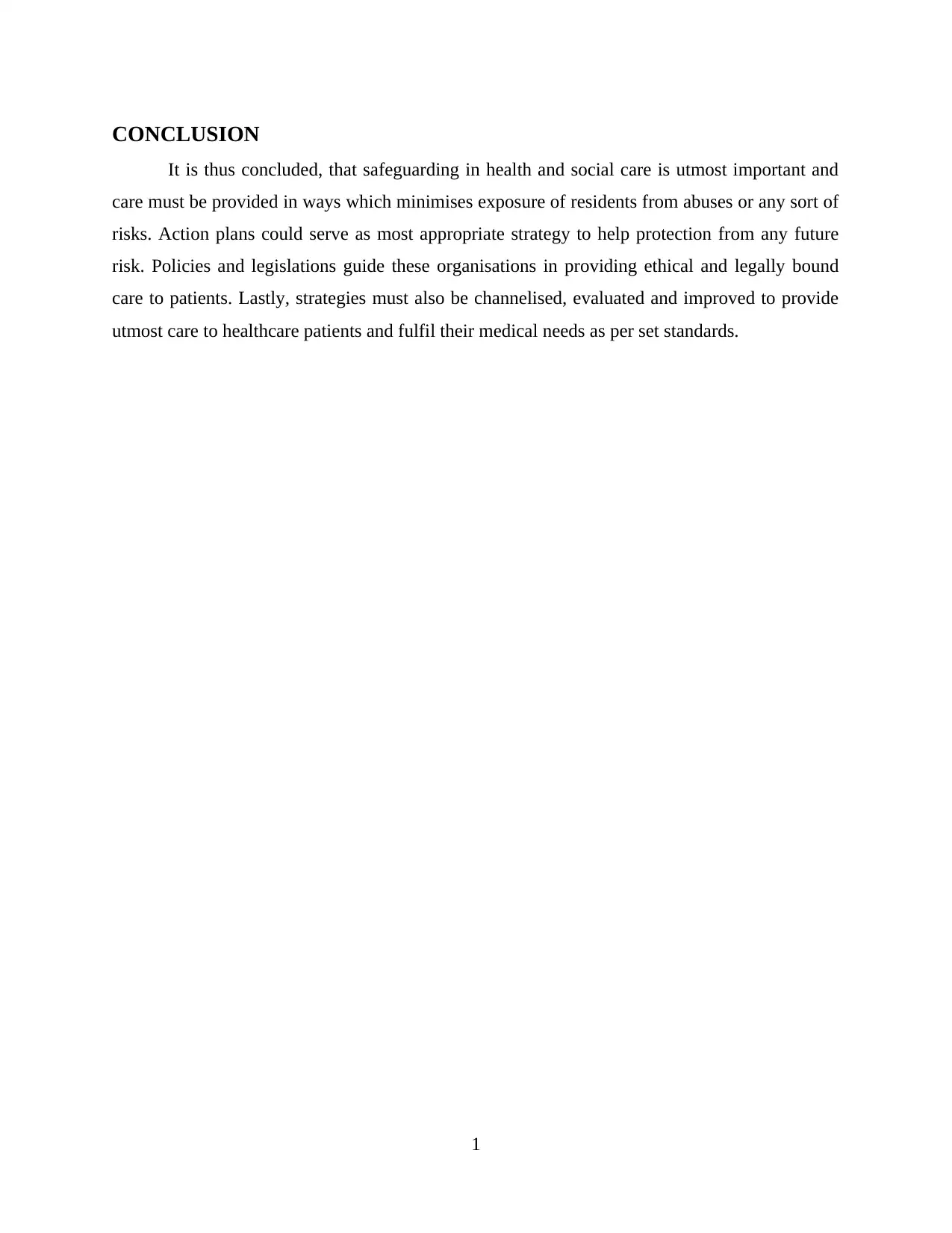
CONCLUSION
It is thus concluded, that safeguarding in health and social care is utmost important and
care must be provided in ways which minimises exposure of residents from abuses or any sort of
risks. Action plans could serve as most appropriate strategy to help protection from any future
risk. Policies and legislations guide these organisations in providing ethical and legally bound
care to patients. Lastly, strategies must also be channelised, evaluated and improved to provide
utmost care to healthcare patients and fulfil their medical needs as per set standards.
1
It is thus concluded, that safeguarding in health and social care is utmost important and
care must be provided in ways which minimises exposure of residents from abuses or any sort of
risks. Action plans could serve as most appropriate strategy to help protection from any future
risk. Policies and legislations guide these organisations in providing ethical and legally bound
care to patients. Lastly, strategies must also be channelised, evaluated and improved to provide
utmost care to healthcare patients and fulfil their medical needs as per set standards.
1
1 out of 11
Related Documents
Your All-in-One AI-Powered Toolkit for Academic Success.
+13062052269
info@desklib.com
Available 24*7 on WhatsApp / Email
![[object Object]](/_next/static/media/star-bottom.7253800d.svg)
Unlock your academic potential
Copyright © 2020–2025 A2Z Services. All Rights Reserved. Developed and managed by ZUCOL.





